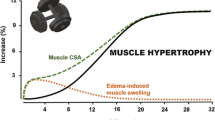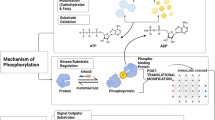Summary
The myosin heavy chain (MHC) composition of single muscle fibres in developing sheep tibialis cranialis muscles was examined immunohistochemically with monoclonal antibodies to MHC isozymes. Data were collected with conventional microscopy and computerized image analysis from embryonic day (E) 76 to postnatal day (PN) 20, and from adult animals. At E76, 23% of the young myofibres stained for slow-twitch MHC. The number of these fibres considerably exceeded the number of primary and secondary myotubes. By E100, smaller fibres, negative for slow-twitch MHC, encircled each fibre from the initial population to form rosettes. A second population of small fibres appeared in the unoccupied spaces between rosettes. Small fibres, whether belonging to rosettes or not, did not initially express slow-twitch MHC, expressing mainly neonatal myosin instead. These small fibres then diverged into three separate groups. In the first group most fibres transiently expressed adult fast myosin (maximal at E110–E120), but in the adult expressed slow myosin. This transformation to the slow MHC phenotype commenced at E110, was nearing completion by 20 postnatal days, and was responsible for approximately 60% of the adult slow twitch fibre population. In the other two groups expression of adult fast MHC was maintained, and in the adult they accounted for 14% (IIa MHC) and 17% (IIb MHC) of the total fibre numbers. We conclude that muscle fibre formation in this large muscle involves at least three generations of myotube. Secondary myotubes are generated on a framework of primary myotubes and both populations differentiate into the young myofibres which we observed at E76 to form rosettes. Tertiary myotubes, in turn, appear in the spaces between rosettes and along the borders of fascicles, using the outer fibres of rosettes as scaffolds.
Similar content being viewed by others
References
Ashmore, C. R., Robinson, D. W., Rattray, P. &Doerr, L. (1972) Biphasic development of muscle fibers in the fetal lamb.Expl Neurol. 37, 241–55.
Bader, D., Masaki, T. &Fischman, D. A. (1982) Immunochemical analysis of myosin heavy chain during avian myogenesisin vivo andin vitro in chicken skeletal muscle.Dev. Biol. 95, 763–70.
BÄr, A. &Pette, D. (1988) Three fast myosin heavy chains in adult rat skeletal muscle.FEBS Lett. 235, 153–5.
Bardeen, C. R. (1900) The development of the musculature of the body wall in the pig, including its histogenesis and its relations to the myotomes and to the skeletal and nervous apparatus.Johns Hopkins Hosp. Reports 9, 367–99.
Brooke, M. H. &Kaiser, K. K. (1970) Three myosin adenosine triphosphate systems: the nature of their pH lability and sulfhydryl dependence.J. Histochem. Cytochem. 18, 670–2.
Condon, K., Silberstein, L., Blau, H. M. &Thompson, W. J. (1990) Development of muscle fibre types in the prenatal rat hindlimb.Dev. Biol. 138, 256–74.
Couteaux, R. (1941) Rechérches sur l'histogenèse du muscle strié des mammifères et al formation des plaques motrices.Bull. Biol. Franco Belg. 75, 101–39.
Dimario, J., Buffinger, N., Yamada, S. &Strohman, R. C. (1989) Fibroblast growth factor in the extracellular matrix of dystrophic (mdx) mouse muscles.Science 244, 688–90.
Draeger, A., Weeds, A. G. &Fitzsimons, R. B. (1987) Primary, secondary and tertiary myotubes in developing skeletal muscle: a new approach to the analysis of human myogenesis.J. Neurol Sci. 81, 19–43.
Duxson, M. J. &Usson, Y. (1989) Cellular insertion of primary and secondary myotubes in embryonic rat muscles.Development 107, 243–51.
Duxson, M. J., Usson, Y. &Harris, A. J. (1989) The origin of secondary myotubes in mammalian skeletal muscles: ultrastructural studies.Development 107, 743–50.
Ecob-Prince, M., Hill, M. &Brown, W. (1989) Immunocytochemical demonstration of myosin heavy chain expression in human muscle.J. Neurol. Sci. 91, 71–8.
English, A. W. &Weeks, O. I. (1987) An anatomical and functional analysis of cat biceps femoris and semitendinosis muscles.J. Morphol. 191, 161–75.
Gambke, B. &Rubinstein, N. A. (1984) A monoclonal antibody to the embryonic myosin heavy chain of rat skeletal muscle.J. Biol. Chem. 259, 12092–100.
Gans, C., Loeb, G. E. &De Vree, F. (1989) Architecture and consequent physiological properties of the semitendinosis muscle in domestic goats.J. Morphol. 199, 287–97.
Gaunt, A. S. &Gans, C. (1990) Architecture of chicken muscles: short fibre patterns and their ontogeny.Proc. R. Soc. Lond. B 240, 351–62.
Guth, L. &Samaha, F. J. (1970) Procedure for the histochemical demonstration of actomyosin ATPase.Exp. Neurol. 28, 365–7.
Harris, A. J. (1981) Embryonic growth and innervation of rat skeletal muscles. I. Neural regulation of muscle fibre numbers.Phil. Trans. R. Soc. Lond. B 293, 257–77.
Harris, A. J., Fitzsimons, R. B. &Mcewan, J. C. (1989a) Neural control of the sequence of expression of myosin heavy chain isoforms in foetal mammalian muscles.Development 107, 751–69.
Harris, A. J., Duxson, M. J., Fitzsimons, R. B. &Rieger, F. (1989b) Myonuclear birthdates distinguish the origins of primary and secondary myotubes in embryonic mammalian skeletal muscles.Development 107, 771–84.
Hoh, J. F. Y. (1991) Myogenic regulation of mammalian skeletal muscle fibres.News Physiol. Sci. 6, 1–6.
Kelly, A. M. (1983) Emergence of specialization of skeletal muscles. InHandbook of Physiology, Section 10 (edited byPeachey, L. D.) pp. 507–37. Baltimore: Williams and Wilkins.
Kelly, A. M. &Zacks, S. I. (1969) The histogenesis of rat intercostal muscle.J. Cell Biol. 42, 135–53.
Loeb, G. E., Pratt, C. A., Chanaud, C. M. &Richmond, F. J. R. (1987) Distribution and innervation of short, interdigitated muscle fibres in parallel-fibered muscles of the cat hind-limb.J. Morphol. 191, 1–15.
Mclennan, I. S. (1983) Neural dependence and independence of myotube production in chicken hindlimb muscles.Dev. Biol. 98, 287–94.
Macqueen, J. B. (1967) Some methods of classification and analysis of multivariate observations.Proc. Vth Berkeley Symposium on Mathematical Statistics and Probability,1, 281–97.
May, N. (1970)The Anatomy of the Sheep. A Dissection Manual. Brisbane: University of Queensland Press.
Mayne, R. &Sanderson, R. D. C. (1985) The extracellular matrix of skeletal muscle.Coll. Relat. Res. 5, 449–68.
Moss, F. P. &Leblond, C. P. (1970) Nature of dividing nuclei in skeletal muscle of growing rats.J. Cell Biol. 44, 459–62.
Ontell, M. &Dunn, R. F. (1978) Neonatal muscle growth: a quantitative study.Am. J. Anat. 152, 539–56.
Ontell, M. &Kozeka, K. (1984) The organogenesis of murine striated muscle: a cytoarchitectural study.Am. J. Anat. 171, 133–48.
Patterson, H. D. &Thompson, R. (1971) Recovery of interblock information when block sizes are unequal.Biometrika 58, 545–54.
Pernus, F. &Erzen, I. (1991) Arrangement of fibre types within fascicles of human vastus lateralis muscle.Muscle Nerve 14, 304–9.
Pette, D. &Vrbova, G. (1985) Neural control of phenotypic expression in mammalian muscle fibres.Muscle Nerve 81, 676–89.
Richmond, F. J. R., McGillis, D. R. R. &Scott, D. A. (1985) Muscle-fibre compartmentalization in cat splenius muscles.J. Neurophysiol. 53, 868–85.
Ross, J. J., Duxson, M. J. &Harris, A. J. (1987) Formation of primary and secondary myotubes in rat lumbrical muscles.Development 100, 383–94.
Salmons, S. &Sreter, F. A. (1976) Significance of impulse activity in the transformation of skeletal muscle type.Nature 263, 30–4.
Salmons, S. &Henriksson, J. (1981) The adaptive response of skeletal muscle to increased use.Muscle Nerve 4, 94–105.
Schwann, T. (1847) InMicroscopical researches into the accordance in the structure and growth of animals and plants. pp. 129–41. London: Sydenham Society.
Stockdale, F. E. &Miller, J. B. (1987) The cellular basis of myosin heavy chain isoform expression during development of avian skeletal muscles.Dev. Biol. 123, 1–19.
Suzuki, A. &Cassens, R. G. (1983) A histochemical study of myofibre types in the serratus ventralis thoracis muscle of sheep during growth.J. Anim. Sci. 56, 1447–58.
Swatland, H. J. &Cassens, R. G. (1972) Muscle growth: the problem of muscle fibre with an intrafascicular termination.J. Anim. Sci. 36, 336–44.
Swatland, H. J. &Cassens, R. G. (1973) Inhibition of muscle growth in fetal sheep.J. Agric. Sci. 80, 503–9.
Tello, J. F. (1917) Genesis de las terminaciones nerviosas motrices y sensitivas.Trab. Lab. Invest. Biol. Univ. Madrid 15, 101–99.
Turner, T. C. (1986) Cell-cell and cell-matrix interactions in the morphogenesis of skeletal muscle. InDevelopmental Biology, 3 (edited bySteinberg, M. S.) pp. 205–24. New York: Plenum Press.
Vivarelli, E., Brown, W. E., Whaler R. G. &Cossu, G. (1988) The expression of slow myosin during mammalian somatogenesis and limb bud differentiation.J. Cell Biol. 107, 2191–7.
Whalen, R. G., Harris, J. B., Butler-Browne, G. S. &Sesodia, S. (1990) Expression of myosin isoforms during notexin-induced regeneration of rat soleus muscles.Dev. Biol. 141, 24–40.
Wigmore, P. M. &Stickland, N. C. (1983) Muscle development in large and small pig fetuses.J. Anat. 137, 235–45.
Wilson, S. J., McEwan, J. C., Sheard, P. W. &Harris, A. J. (1992) Early stages of myogenesis in a large mammal: formation of successive generations of myotubes in sheep tibialis cranialis muscle.J. Muscle Res. Cell Motil. 13, 534–50.
Wohlfart, G. (1937) über das Vorkommen verschiedener Arten von Muskelfasern in der Skelettmuskulatur des Menschen und einiger SÄugetiere.Acta Psychiat. (Kbh.) (Suppl.) 12, 1.
Author information
Authors and Affiliations
Rights and permissions
About this article
Cite this article
Maier, A., McEwan, J.C., Dodds, K.G. et al. Myosin heavy chain composition of single fibres and their origins and distribution in developing fascicles of sheep tibialis cranialis muscles. J Muscle Res Cell Motil 13, 551–572 (1992). https://doi.org/10.1007/BF01737997
Received:
Revised:
Accepted:
Issue Date:
DOI: https://doi.org/10.1007/BF01737997




